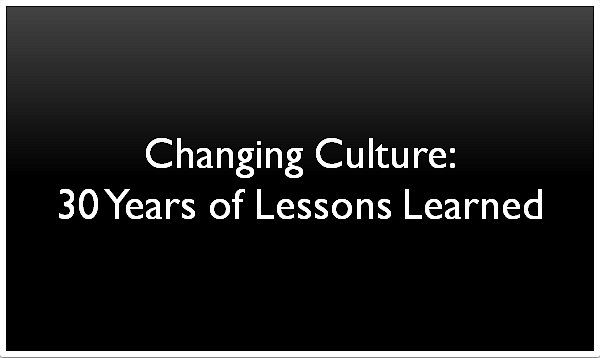Lesson #2: Engaging Leaders, Changing Culture
This article is a draft chapter in Dr. Nancie Evans’ upcoming book, Changing Culture: 30 Years of Lessons Learned. Comments, questions and suggestions are gratefully appreciated. Happy reading!
In an ideal world, senior leaders fully embrace the challenge of changing culture. As explained previously, this means role modeling the expected behaviors, reinforcing them in day-to-day practices, and creating the conditions for success. Unfortunately, I’ve found this rarely happens. It isn’t that leaders don’t understand what it takes to be successful. When asked for examples from their experience, leaders can almost always come up with great stories of both successful and failed efforts. They totally get that they need to lead the way.
Barriers to Leader Engagement
So, what stops leaders from personally owning and fully engaging in culture change? Why do leaders overwhelmingly delegate the heavy-lifting to Human Resources? In years of asking this question to leaders and Human Resource professionals, a few things stand out.
Competing Priorities and Demands
Leaders at all levels and especially those in senior roles are stretched thin. Competing demands mean having to make choices as to where they invest their time, energy and attention. There simply aren’t enough hours in the day and days in the week to do everything. As a result, while culture is viewed by many as important, it often takes a back seat to more urgent demands, such as delivering short-term financial results and day-to-day management of the business. This is not to say they don’t support culture work. In fact, a lot of CEOs and other C-Suite executives sponsor culture change initiatives and personally invest a significant amount of time in defining values, communication and employee engagement. The problem is their involvement falls short of that required to achieve meaningful and sustained change.
Culture Is Vague and Ambiguous
Consider for a moment, the language of business. Products, services, processes, operations, market share, revenues, cost structures and so on are clear and widely understood. Talk about a business process and people know exactly what you mean. It’s tangible with elements that can be measured, analysed and improved. Contrast this with culture which is defined by words like values, beliefs and assumptions or ‘the way things are done around here’. No wonder many leaders’ eyes start to glaze over. Start talking about culture change as requiring a shift in underlying beliefs and we’ve lost them entirely. It is simply too vague and ambiguous to grab their attention.
The Comfort Zone
Faced with a choice of solving an immediate business problem or getting involved in culture change, the former always wins. Even when there are good intentions, there are always more problems to be solved, plans made, and actions taken causing less urgent matters like culture change to take a back seat. This is simply human nature. When under pressure, we tend to deal first with things that fall into our comfort zone and second with those that are urgent and important. If there is time and energy left, and we are sufficiently motivated and confident in our abilities, we might then take on things that are less urgent but important or urgent but complex such as culture change.
Culture Change Is Personal
Culture change almost always requires a shift in leaders’ behavior. Keeping in mind that employees follow the actions of leaders, not so much their words, this means letting go of behaviors that worked in the past but are detrimental in the new world. It means learning or demonstrating new behaviors that include ones outside their comfort zone or inconsistent with their personal beliefs regarding the most effective way to manage and lead. It can also mean the qualities and capabilities that made a leader successful are no longer valued and might even cause them to fail. This can lead to avoidance in the form of passive resistance or an ‘I’m good but the rest of you need to change’ attitude which undermines the change effort.
Experts Advocate a Behavioral or Values-Based Approach
Most Change Management and Human Resource consultants advocate a behavioral or values-based approach to culture change. In this approach, leaders define the organization’s vision, mission, purpose and values; the latter sometimes in consultation with employees. A lot of effort is directed at sharing the values and engaging employees in building the connection with their personal values. Once finalized, Human Resources translate the values into expected behaviors, often in the form of competency models. The expected behaviors are communicated to employees and embedded in orientation and training programs, as well as talent management processes and performance management systems. This approach is appealing to leaders looking for a solution that doesn’t require a lot of their personal time and attention. The fact that it is advocated by experts also lends it credibility, which gives leaders confidence it is the right way to proceed.
It’s a People Thing
Finally, culture change is generally perceived to be a ‘people thing’. After all, it involves defining values and changing behaviors, right? As this is not an area of expertise for most leaders, it should not be surprising that they happily delegate responsibility to Human Resources. In fact, it makes sense for Human Resources to take the lead on most culture initiatives. Human Resource professionals bring much needed skills and expertise to help leaders through the culture change process. The challenge is to convince leaders to retain ownership of culture change with Human Resources as a strategic partner versus doers.
Strategies for Leader Engagement
Culture change is difficult, personally challenging, time consuming and requires a long-term commitment. All good reasons for leaders to search for an easier alternative that minimizes their involvement, especially given the challenges and demands of their jobs. Yet, they must be fully engaged for culture change to have a chance at success. So how do we convince leaders to own culture change?
What Doesn’t Work?
Let’s start with what doesn’t work. I’ve spent countless hours making presentations to leaders with the objective of convincing them that culture is an important business priority. Facts and figures from various studies illustrate the financial, competitive and other benefits of investing in culture. Great articles and case studies provide compelling arguments for the power of culture change. My own research shows the difference culture can make on innovation, customer loyalty, reliability and operational excellence.
If we’re lucky, this is sufficiently compelling to capture their attention and we can proceed to ‘what’s next?’ A lot of the time, however, the conversation stops here, simply because we’re talking about culture not operating models, strategy, business processes or other ‘hard stuff’. For many leaders, culture is just too vague and intangible. For people who are used to having the answers and knowing what to do, this is the kiss of death.
In the end, the vast majority delegate responsibility for culture and culture change to Human Resources but promise to help in (almost) anyway they can, keeping in mind the competing demands for their time and attention, as well as resources. Unfortunately, this rarely includes making the personal or systemic changes required for the culture to shift in a meaningful or sustained way. The bottom-line is leaders perceive that the cost and effort outweigh the benefits. This is magnified by urgent, short-term and more pressing demands, such as achieving the quarter’s revenue targets.
So, what does work?
This might seem crazy but talking to leaders about culture and the need for culture change simply does not work. That is, it doesn’t work unless you anchor it in a business need and provide a clear, practical solution they can understand. In other words, you have to speak their language and employ a business-driven approach.
Speak Their Language
About 10 years ago, a Human Resource executive told me he wished there was another word for ‘culture’. When asked why, he explained that senior leaders view culture as ‘vague, warm and fuzzy; as an HR thing’. As a result, it was close to impossible to get them to see culture as a business priority requiring the same level of attention as say, achieving financial results, improving business processes or developing strategic plans. I didn’t listen but instead directed my energy at strengthening my case. It was only when I finally changed the way I talked about culture that senior leaders began to really engage. The secret is to use language they understand.
This doesn’t mean avoiding the use of the word ‘culture’. In fact, organizations contact me because they want help with their culture. It is the language we use when we talk about culture where the opportunity exists. Terms like capability instead of culture attributes and expectations rather than behaviors help change the conversation. By using words they can relate to, leaders are more willing to engage in a deep exploration of the challenges and opportunities culture presents.
Take for example Bill, whose story is told in Lesson #1. It reads as if Bill was an enlightened leader intentionally and purposefully leading the way to achieve a meaningful change in culture. The thing is, according to Bill, the changes he made had nothing to do with culture. It was about effective leadership and business management. He solved a significant business problem by increasing the level of discipline with an emphasis on cost management and decision-making. To him, discipline was a capability, not a culture attribute, the organization lacked. He didn’t talk to people about changing the culture and never mentioned values, beliefs or assumptions. He referred to behaviors as expectations as in, “I expect people to be on time for meetings and appointments”. He didn’t involve Human Resources as, to him, he was simply doing his job so why would he need them? He did engage his direct reports to lead the process changes but otherwise did not involve employees. Based on his experience, he believed he knew what needed to be done and didn’t see value in asking people who, in his mind, didn’t have a clue what discipline was about.
I am not advocating that leaders embark on culture change without involving Human Resources. Nor, do I suggest that engaging employees isn’t worthwhile. In fact, both play an important role and are topics for later chapters. The point is culture change, intentional or accidental, can happen fast when leaders are actively engaged and own it. Changing the way we talk about culture can go a long way towards achieving this, especially when it is accompanied by a business-driven approach.
Use a Business-Driven Approach
Most culture initiatives arise from either a people problem, such as employee attrition or low engagement, or a significant change, such as new senior leadership. Alternatively, a leader might attend a conference, read a book or hear something about culture in the media that catches their attention. While these may be valid reasons for initiating culture work, they rarely lead to the type of leader engagement required to achieve a meaningful outcome. For this to happen, senior leaders must see culture as a business priority on par with other challenges and opportunities. But, how to do this?
I’ve found that two conditions need to be met. The first is there must be sufficient pain as a result of culture related challenges to make it a priority. Pain can be pretty much anything that is interfering with the organization’s ability to achieve its goals. Difficulties executing strategy, integration challenges in a merger or acquisition, loss of top talent to competitors, capacity and scalability issues, declining financial results and loss of market share are just a few examples. The thing is most leaders don’t see these sort of challenges as having anything to do with culture, which leads to the second condition.
Leaders must be open to considering that culture may be a factor contributing to the pain and/or getting in the way of effectively dealing with it. This isn’t necessarily easy as most leaders are sceptical when we talk about culture change as a solution to a business problem. This is, of course, entirely expected and reasonable given there are likely several factors contributing to the pain. These can be internal, such as outdated technology or inefficient work processes, and external, including the entry of new competitors, changing customer expectations and so on.
Trying to convince leaders that changing the culture will solve their problem is misguided and not going to work. What we want is for them to consider that while culture may not be the entire answer, it may well be a critical part of the solution. To this end, I never, ever talk about culture as the problem and culture change as the solution. Instead, the focus is on the business problem with capability development part of the solution. This is where using business language versus culture speak can make a difference. We start with engaging leaders in conversations about the business problem, not the culture, then expand the conversation to explore capabilities and the changes required to close the gaps that may exist.
Translate Their Role into Tangible Actions
What about convincing leaders to accept their role and lead the way? I’ve found the best approach is to not make this an up-front condition for embarking on culture change. Better yet, don’t talk about it at all until there is something tangible to discuss. Asking leaders to embrace a role that sounds vague, time intensive, uncomfortable and potentially threatening without this is setting ourselves up to fail.
By tangible, I mean the specific actions they need to take to close the capability gaps they identify. This includes behaviors, practices and creating the right set of conditions defined in very concrete terms. If for example, they identify the need for heightened agility, the required actions might include increasing delegation of authority limits, committing to a 24-hour response to requests for decisions, streamlining the approval process to a two-step process, and limiting Legal’s role in decision-making. These are very concrete actions leaders understand and know how to implement. This doesn’t mean they are easy, but they are manageable and achievable. If we accompany the actions with a plan that is realistic and has a high probability for personal and organizational success, we’re off to the races.
By speaking their language, using a business-driven approach and making their role tangible, we have significantly increased the probability that leaders will personally engage in culture change. The good news is this isn’t difficult for most Human Resources and Organization Development/Effectiveness professionals. We’re used to talking about business problems, gaps, solutions and action plans. You can’t be successful without this. All we need to do is apply the same language and approach to culture. The following case study, A Culture Conversation with Bob, provides an example of the first two strategies. Although the specifics vary depending on the situation and leader, the basic conversation framework absent probes and follow-up questions are the same. The topic of tangible actions is explored in a later chapter.
A Culture Conversation with Bob, CEO Transportation Company
The following dialogue is an abbreviated version of a recent conversation with the CEO of a major transportation company. To facilitate the conversation, I always bring a set of Culture Cards and Images with me and pull these out when it makes sense. These types of tools are effective in focusing the conversation on culture without using culture-specific language. The cards I use are from a model based on my research and are consistent with the work of other experts including Geert Hofstede, Roger House and Fons Von Trompenaars.
Question: What challenges are keeping you up at night?
Answer: We must successfully implement several new, large and complex initiatives while at the same time continuing to conduct business-as-usual and meet market expectations. This involves doing things we’ve never done before. I’m concerned that we won’t be able to deliver; that we’ll fail to deliver the expected financial results. If this happens, we will be under even more pressure and closer scrutiny than ever making it increasingly difficult to do what we need to do.
Question: What does success look like?
Answer: The bottom line is we hit our numbers and meet or exceed market expectations. This requires that we launch our new low-cost service on time and within budget; drastically reduce operating costs in our existing lines of business; and, complete a major technology upgrade without disrupting the business, on time and within budget. At the same time, we must maintain or improve our current level of service to our customers, retain our top talent and attract new employees with the skills we need for the future. I’m not optimistic. We’re already experiencing delays that are threatening both the launch of the new service and the systems upgrade.
Question: What could cause you to fail ?
Answer: It’s too much. We’re stretched very thin given our current resources and capacity. People are already showing signs of burnout and I’m very worried we’re going to start losing not just our top talent but also the people we need to keep our core business running. Ideally, I would like to focus on streamlining work processes, getting rid of waste and increasing capacity before launching the new service offer and doing the technology upgrade. The problem is we can’t wait. We’re already being threatened by the imminent arrival of new competitors who are entering our market with a low-cost service. Our existing technology is old and can’t handle what we need it to do to be able to compete. Bottom-line is we must figure out how to make it all happen.
Question: What capabilities are needed to successfully meet these challenges and deliver the expected results? Capabilities are the abilities required to achieve your goals.
Answer: First, we need project management skills to make sure we plan and implement the changes effectively and efficiently. That’s why we’ve set up a Project Management Office to work with the business teams. Second, we must execute with excellence which requires discipline and doing things right the first time. We don’t have a good track record at this. We’re great at generating ideas but pathetic when it comes to execution and follow through. Collaboration across groups is another area where we fall short. The challenges we’re facing aren’t isolated to one group or another. It is going to take all parts of the business working together to be successful. We can’t continue to fight over resources and have competing priorities. We must be aligned with our priorities. This means accepting that some groups are going to get more than others. This is simply the way it is. We only have so many resources and we need to use them where it matters most. At the same time, we can’t lose sight of our people. We must show they are valued, and we care. Managers are going to have to spend time communicating and listening and do the big and little things required to keep their staff engaged. We cannot afford to lose talent due to stress and burnout. We also absolutely must stay focused on our customers and continue to deliver the exceptional experience we’re known for. This has been a key differentiator for us, and we can’t let it suffer, especially with all the changes happening and potential for uncertainty in how we are covered in the media. Finally, we absolutely must meet our numbers. Failure to achieve our financial targets would be disastrous. Funding for capital projects would be pulled back impacting our ability to move forward with the initiatives we must implement to keep pace with our competitors.
Question: What capabilities are existing strengths ? Strengths are capabilities to protect and use to address the business challenge.
Answer: Our strengths are employee engagement, customer focus and doing what it takes to get results.
Employee Engagement. Our employees really care about our customers, the company and each other. They are passionate and take great pride in our successes. We need to protect this as it may be at risk given what I’m hearing about employee burnout.
Customer Focus. A big part of who we are is our commitment to providing every customer with a great experience. We genuinely care and treat each customer as a friend, family and neighbor. Our challenge is to find a balance between doing what is best for a single customer with what is best for all customers and the company. While this is a strength, it is also a challenge we are going to have to address.
Results Focus. Our employees step up and do whatever it takes to meet commitments, although this is becoming increasingly difficult. They must overcome significant obstacles such as broken processes, lousy technology and heavy workloads to make this happen. I’m seeing some cracks. We are still delivering on the big things, but people are taking shortcuts, which is causing issues with quality. Some of the lesser priorities are also being missed as employees make choices where they direct their time and energy. We have to be careful they focus on the right things, which means being very clear and consistent when setting priorities.

Culture Strategy Fit’s Culture Cards
Question: What capability gaps do we need to close ? Capability gaps are the abilities required but lacking in the organization.
Answer: The main ones are those I already mentioned. Project management skills. Execution excellence. Collaboration across groups. Managing our resources effectively. Aligning on our priorities. At the same time, we must manage employee burnout and continue to meet or exceed customer expectations while achieving our financial targets. All of these are important. We also have to do a better job communicating what’s happening and why it’s important to our employees.
Question: Select an image that best captures what you mean by [capability gap]. Culture Images are very useful in facilitating this discussion. I bring a set of 20 and asked Bob to pick one.
Note: The purpose of the image is to avoid the assumptions that often accompany words. For example, agility means different things to different people. To some, it means full autonomy to make decisions. To others, it is an approach borrowed from agile development in software engineering.
Answer: Bob selected an image of a chef’s kitchen in a high-end restaurant.
Question: Why did you select this image?

Changing the Organizational Culture – Engage the Leader
Answer: A kitchen in a high-end restaurant runs like a well-oiled machine. Every person in that kitchen knows exactly what they need to do to make sure they deliver a meal that meets or exceeds their customers’ expectations. There are distinct roles with different responsibilities,but they work together seamlessly. They have the best of tools, such as equipment, food and so on, available to them. They are efficient and effective and do not waste resources. Everyone knows what they need to do, pay attention to detail, communicate and meet their commitments. They trust each other implicitly. They have exceptionally high standards and execute flawlessly. They deliver.
We need to be like this. We need to work together and execute seamlessly, work together, communicate and get results with the customer front and center at all times.
Question: What changes are needed to make this happen?
Note: Time permitting, this is an opportunity to get leaders starting to think about possible solutions.
Answer: The most pressing priority is to create capacity for the major initiatives we have planned. We need to stop doing things that aren’t adding value, streamline decision-making, get rid of out-dated policies and processes and anything else that is not essential. It also means saying no to new opportunities, no matter how tempting they are…we aren’t good at this. We like to chase after shiny new things. We also have to put a stop to some of the things we would like to do but simply can’t because of resources. This means discontinuing work on several important initiatives currently underway. People aren’t going to like this.
In other words, we can’t be a well-oiled machine without making some fundamental changes. We have to strengthen our foundation by getting back to basics. And, we must do it together as a team. Every leader and employee must get on board and do what is needed for us to be successful. We can’t continue to operate in fiefdoms protecting turf and resources.
End of conversation.
In Summary
The conversation with Bob is an example of a culture conversation that isn’t about culture. It is about the business. The challenges keeping him up at night. The obstacles getting in the way. The capabilities required. The changes needed. This might seem disingenuous and, to a point, it is. It is also effective. By speaking his language and focusing on the business, we are operating in his world of hard facts and concrete actions. This is something every leader can relate to. After all, problem-solving is what they are good at.
In fact, it is something every person working in or with an organization learns if they are to be successful. This means you are probably already doing this. If you are in Human Resources, you deal with business problems and solutions all the time. The difference is you can use words like talent acquisition and leaders know what you mean. You don’t have to translate this for them. If you’re having trouble attracting the right people, leaders understand the implications. The difference with culture is we have to make it understandable. We have to translate a ‘soft’ and vague concept into something concrete and relatable. Only by speaking their language, using a business-driven approach and defining tangible actions do we have a realistic chance of engaging leaders in a meaningful way in culture change.
In sum, leader engagement in culture change is absolutely essential but very difficult to achieve. There are so many obstacles getting in the way. To overcome them requires a new way of thinking, talking and approaching culture and culture change. It requires a paradigm shift.
Dr. Nancie Evans
 Dr. Nancie Evans is co-founder and VP Client Solutions at Culture-Strategy Fit Inc. specializing in the alignment of organizational culture and strategy. She has developed a unique set of leading-edge diagnostic tools and approaches that provide leaders with deep insights into the culture of their organizations, how it is supporting or getting in the way of strategy execution, as well as the levers that they can use to drive rapid culture change.
Dr. Nancie Evans is co-founder and VP Client Solutions at Culture-Strategy Fit Inc. specializing in the alignment of organizational culture and strategy. She has developed a unique set of leading-edge diagnostic tools and approaches that provide leaders with deep insights into the culture of their organizations, how it is supporting or getting in the way of strategy execution, as well as the levers that they can use to drive rapid culture change.
Culture-Strategy Fit®
Culture-Strategy Fit Inc. is a leading culture and executive leadership consulting firm conducting groundbreaking work in leveraging culture to drive strategy and performance. It’s suite of culture surveys and culture alignment tools are used by market-leading organizations around the world.
Contact Us
1.800.976.1660
nancie@culturestrategyfit.com
The post Lesson #2: Engaging Leaders, Changing Culture appeared first on Culture Strategy Fit.










